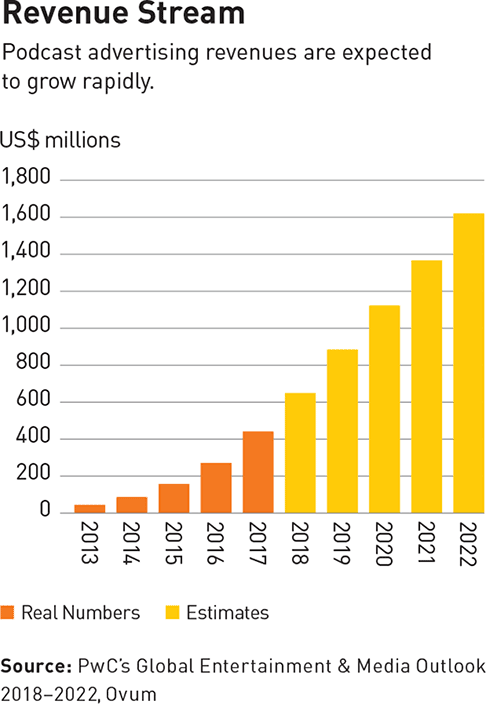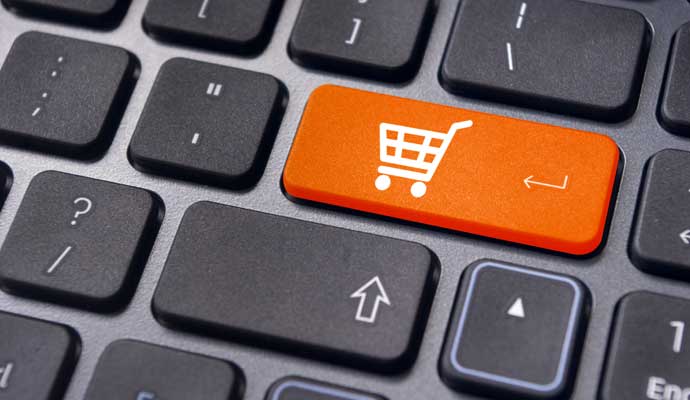The Podcasting Revenue Boom Has Started
As advertising revenues begin to catch up with the growth of the medium, podcasting is building the infrastructure of a billion-dollar media industry.
How many media sectors have seen their revenues, driven primarily by advertising, rise nearly ten-fold in the previous four years? And how many expect their revenues to nearly quadruple from their current level by 2022? At least one. According to the latest PwC’s Global Entertainment & Media Outlook 2018-2022, podcasting is poised to grow into a nine-figure component of the global media landscape.
Podcasts have been around for more than a decade. But it is only in recent years that the financial and logistical infrastructure that supports podcasting as a business has been erected. Now, as a result, revenues are projected to grow at a nearly 30 percent annual rate between 2018 and 2022 (see “Revenue Stream”). Even as some observers warn of a bubble in podcasting production and distribution, it is clear that a revenue boom is underway.
Podcasting began, like so many media sectors, as a low-concept cottage industry. Audio files that can be downloaded on demand started out as repackaged talk-radio shows, recorded comedy routines, and technology “nerdcasts.” Listeners accessed them on PCs, then iPods, and eventually smartphones, smart speakers, and other mobile devices. A few early advertisers took a flyer on the burgeoning sector, with global podcasting ad sales totaling a mere US$45 million in 2013 (compared with $40.2 billion for total radio revenues).
The industry got a jolt in 2014, when Serial, an investigative journalism series, attracted unprecedented millions of listeners. In the years since, listenership and podcast production have risen exponentially. As is typically the case with new media segments, however, advertisers follow users’ attention slowly with their dollars.
“Serial was the moment at which that young media buyer, who was trying to put a podcast ad on a plan but ran into resistance from her boss, suddenly got some receptivity,” says Erik Diehn, CEO of Stitcher, a podcast content, distribution, and advertising network owned by E.W. Scripps. “All of a sudden, ad agencies had people focused on podcasts.”
Numerous factors have contributed to the emergence of podcasts as an increasingly attractive medium for marketers deploying digital advertising. First, the audience has attained critical mass. The number of podcast listeners — defined as those who have listened to at least one podcast in the past month — surged to 78 million by the end of 2017, up from 23 million in 2013, according to the E&M Outlook. Simultaneously, the podcast universe has exploded to more than 500,000 shows, and the quality of the content and production values have gone up, as well.
The self-reinforcing growth of audience and content has generated a corresponding rise in ad revenues, albeit on a time delay. There is always a significant lag between where audience attention flows and where ad dollars follow. “Remember what happened in cable television,” says Hernan Lopez, founder and CEO of podcast producer Wondery, recalling the slow migration of first viewers and then marketers from broadcast television. “Better content attracted more viewers, which attracted more [advertising] revenue.”
PwC’s Global Entertainment & Media Outlook 2018–2022
For more on entertainment and media trends, see PwC’s five-year projection of consumer and advertiser spending data across 15 industry segments and 53 territories. www.pwc.com/outlook
Podcasting still has a long way to go if it is to have a similar impact on terrestrial radio. U.S. podcast advertising captured $314 million in revenue in 2017, a gain of 86 percent over $169 million in 2016, according to the most recent IAB/PwC Podcast Advertising Revenue Study, released in June by the Interactive Advertising Bureau (IAB). On a global basis, podcasting advertising revenues will total $650 million in 2018, compared with $45.2 billion total revenues for the global radio industry. Put another way, podcasting ad revenues are 1.4 percent of total radio revenues. And both industries are projected to grow in the coming years. The E&M Outlook projects global podcasting revenues will grow at a 29.7 percent compounded annual growth rate (CAGR) through 2022, while radio revenues are projected to grow at a modest 1.9 percent CAGR in the same period. By 2022, radio revenues of $48.6 billion will still dwarf the $1.6 billion in podcast revenues.
Still, if there’s comparatively little evidence that podcasting is taking money away from radio, there is some evidence that consumers are switching to podcasts from other audio formats. The E&M Outlook mentions a 2017 study by podcast distributor Audioboom, which found that 68 percent of podcast listeners had reduced the time they spent listening to broadcast radio in favor of podcasts.
Although they’re not abandoning radio by any means, marketers are dialing in to podcasting because of the appealing demographics associated with its audience. According to the 2018 Infinite Dial survey from Edison Research and Triton Digital, nearly 180 million Americans, or 64 percent of the potential listening population, are familiar with the term podcasting, 44 percent have listened to at least one, and 17 percent listen weekly. Consumers aged 18–34 are most likely to be monthly podcast listeners, and among those, 16 percent have an annual household income of $150,000 or more and 27 percent have a four-year college degree.
While not abandoning radio by any means, marketers are dialing in to podcasting because of the appealing demographics associated with its audience.
The nature of podcasting — engaging hosts who build a trustful rapport with loyal listeners — has influenced the types of ads they attract. Borrowing a successful format popularized by radio broadcaster Paul Harvey in the 1950s, podcasters often deploy host-read ads. These ads, in which hosts tacitly or explicitly endorse products or services, comprised more than two-thirds of podcast campaigns last year, followed by brand-awareness ads (29 percent), according to the IAB/PwC study. Direct-response ads transacted on a cost-per-thousand (CPM) basis, most accompanied by a promo code or web address, accounted for the majority of the buys. It’s little wonder, then, that direct-to-consumer disruptors — so-called challenger brands seeking to establish relationships with young consumers, such as Casper, Blue Apron, Dollar Shave Club, and Warby Parker — have moved aggressively into podcasting advertising.
Now there are signs that established brands want a piece of the podcast pie, too, so names like Gillette, Mattress Firm, Ford, and IBM are showing up. Last December, Big Blue advertised on five different podcasts, and in April, in conjunction with its “Let’s Put Smart to Work” campaign, IBM ads appeared on shows including Science Friday and Freakonomics Radio. Stuff Media, which in September 2018 was purchased by iHeartMedia for $55 million, has run ads on its popular HowStuffWorks podcasts from such major brands as Gillette, Dell, Lowe’s, NBC, and Pitney Bowes.
More big brands are being drawn in not solely by the burgeoning audiences, but by the development of a more mature infrastructure surrounding the serving and measurement of podcasting ads.
Until recently, podcasters reported their audience sizes by simply counting downloads. But that practice doesn’t provide enough of the rich data and analytics that digital advertisers require from other media. Apple, whose iTunes store and iOS podcast app have made it predominant in the genre, introduced a long-awaited analytics service in January 2018. It offers podcasters the ability to track unique devices and playback metrics for their podcasts, including when listeners drop off during a show and whether they skip through ads. “It proved right away what we already believed, that most audiences listen to at least 85 to 90 percent of the episode for most podcasts,” says Trevr Smithlin, CEO of AdvertiseCast, a podcast ad agency. “This is additional data to support the fact that podcast listeners are highly engaged and audiences are actually hearing the ads.”
In December 2017, IAB released an even more robust, stricter set of measurement guidelines (pdf), agreed to across the industry. The new standards have stripped out duplication and false downloads to get closer to the actual number of ears consuming the content, Smithlin explains, “so the IAB metrics ensure that everyone is using the same set of rules and guidelines when reporting downloads.”
The new IAB guidelines are critical, “because they’re going to bring big, branded advertisers into the space,” adds Marshall Williams, CEO of Ad Results Media, an agency specializing in audio advertising. “If we’re going to bring in cars, financial services, airlines, beer, and liquor advertisers, we need a mutually agreed-to set of standards.”
Another momentum-building tool is so-called dynamically inserted advertising (pdf), a technology that programmatically inserts ads at the point of download rather than baking them in at the time of production — the method used for host-read ads. Dynamically inserted ads are placed within the podcast on demand, enabling precise scheduling, targeting, and delivery reporting. They can be served across a range of podcasts, and targeted to a particular audience, time period, or reach and frequency objective.
David Silverman, a PwC US partner in assurance services and the firm’s leader in the IAB/PwC studies, foresees continued growth in podcast advertising. “With advertising in mobile, Internet, and video, in each instance the audience was there before the marketing dollars, and over time the gap closed,” he says. “Similarly, the key in podcasting is continued growth of the audience, so the overall pie grows.”
Author profile:
- Bob Woods is a writer based in Madison, Conn., who specializes in sports, entertainment, and media business topics.





